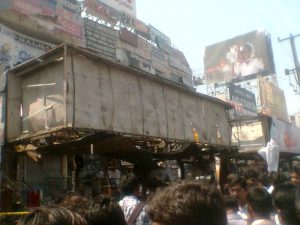On 21 February 2013, twin blasts in a crowded market in Hyderabad shocked the country. The relevant facts about Hyderabad twin blast 2013 are mentioned in this article.
See previous ‘This Day in History’ in the linked article.
The IAS Exam aspirants can refer to the table below to find similar important topics for UPSC CSE preparation.
| UPSC Mains GS 3 has topics like Internal Security Challenges in India, Extremism, Terrorism, Money-Laundering etc.
Aspirants can cover the topics mentioned in the UPSC Syllabus by following the below-mentioned links: |

The damaged bus stand in Dilsukhnagar
Hyderabad Blasts Feb 21 Details
- On 21 February 2013, two bomb blasts ripped through Dilsukhnagar in Hyderabad in Telangana state (then in Andhra Pradesh).
- Dilsukhnagar is a crowded shopping market area. The first blast occurred at 7:02 PM at Anand Tiffins while the second one went off at 7:06 PM between the bus stand in Dilsukhnagar and Venkatadri Theatre.
- CCTV footage revealed that five men had placed the bombs on parked bicycles.
- The bombs were Improvised Explosive Devices (IEDs) that were packed with a lot of iron nails and bolts, and ammonium nitrate, all bound together by a copper string, to afflict maximum damage.
- At least 18 people were killed and about 130 people suffered injuries as a result of the twin blasts.
- Hyderabad Police took up the investigation while they were joined by the National Investigation Agency (NIA) and the National Security Guard (NSG). The NIA and the NSG arrived in the city onboard a plane provided by the Border Security Force (BSF).
- The Hyderabad Police questioned several people in connection with the blasts. The NIA held many raids in Bihar, Uttar Pradesh and Maharashtra.
- It was revealed that the Delhi Police had obtained information regarding the Indian Mujahideen (IM) conducting reconnaissance activity in Dilsukhnagar when they interrogated an IM member Maqbool in 2012.
- The IM was charged with the blasts. Its founder Yasin Bhatkal was caught near the Nepal border. Five people were arrested and charged with the crime of waging war with India and other charges. Apart from Bhatkal, others charged were Zia-ur-Rahman (Pakistani national), Ajaz Shaikh, Asadullah Akhtar and Tahaseen Akhtar. In December 2016, the five men were sentenced to death.
- It was also revealed that the terrorists had initially targeted a temple in the vicinity but dropped that plan because of a visit by the Hyderabad Police Commissioner to the temple.
- Immediately after the cowardly attacks, major Indian cities were put on high alert.
- The Indian Mujahideen is considered by investigators to be composed of former SIMI members. It has been involved in several terrorist attacks in India. It is banned in India, the USA, UK and New Zealand.
| Also on this day
1829: Death of Kittur Rani Chennamma, who waged a rebellion against the British in 1824. 1848: Karl Marx and Friedrich Engels published the ‘Communist Manifesto’. 1878: Birth of Mirra Alfassa, Auroville’s ‘Mother’ and associate of Sri Aurobindo. 1894: Birth of Sir Shanti Swaroop Bhatnagar, eminent scientist and ‘Father of research laboratories’. |
UPSC Preparation:
Comments